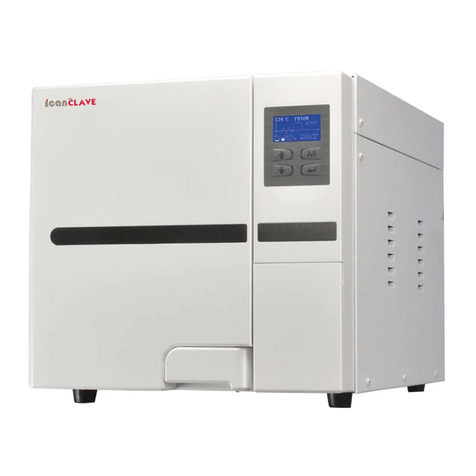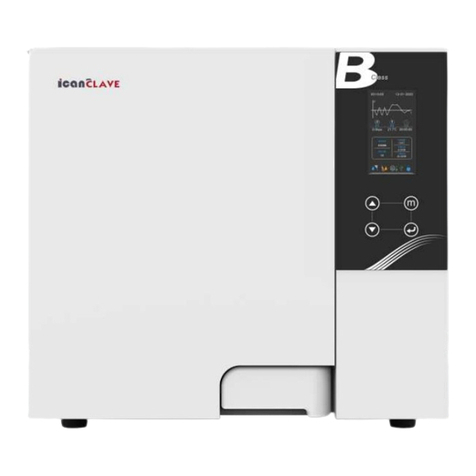
From an external container
Connect the supplied tube to the front fitting of the sterilizer.
Insert the other end of the tube with the filter into the container with distilled water.
Tap the distilled water tank “fresh water” icon to operate the water pump and maintain it pressed until the
message (filling the tank) appears.
The pump charges the clean water tank located at the top of the sterilizer, the capacity of the tank is 4.0
liters approx.
If after 240 seconds the tank has not reached the maximum level, the pump will stop, and it will be
necessary to press again the distilled water tank icon to finish filling the tank.
Once the maximum level has been reached, the pump stops automatically.
Fixed water feeding
When the Icanclave water system is connected, the device will fill the distilled water tank every time it
reaches its minimum level.
To install the water system, follow the instructions given together with the Icanclave water device.
Drain the distilled water tank
Attach the drain hose on a fitting connection located on the back of the sterilizer. Pull the connector to
star the draining.
Attention: The capacity of the distilled water tank is approximately 4 liters.
Drain the used water tank
Attach the drain hose on a quick fitting connection located inside the service door at the left.
Attention: The capacity of the used water tank is approximately 2 liters.
Preparation of sterilization materials
For the most effective sterilization and to preserve the sample, please follow below:
▪Clean instruments immediately after use.
▪Treat the instruments by ultrasound cleaner.
▪Residual chemicals left over after cleaning and disinfecting process may damage and corrode
parts of the sterilizer, always rinse off the instruments using distilled water.
▪Follow instrument manufacturer’s guidelines and recommendations for handing and cleaning
instruments prior to sterilization.
▪Check the manufacturer’s instructions as to proper procedure for sterilizing of each item.
▪Arrange the samples of different materials on different trays or with at least 3cm of space
between them.
▪Clean and dry instruments thoroughly before placing them into tray.
▪Always insert a sterilization paper or cloth between the tray and sample to avoid direct contact.
▪Arrange the containers (glasses, cups, test-tubes, etc.) on one side or inverted position,
avoiding possible water stagnation.
▪Don’t stack the trays one above the other or put them in direct contact with the walls of the
sterilization chamber.
▪Always use the instrument tray handle.
▪Wrap the samples one by one or, if more tools have to be set in the same bag, verify that these
are made of the same material.
▪Don’t use metallic clips, pins or other, as this jeopardizes the maintenance of the sterilizer.
▪Don’t overload the trays over the stated limit (see appendix 2).






























